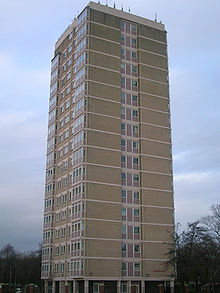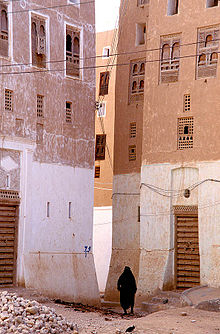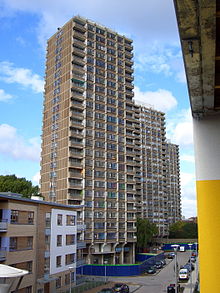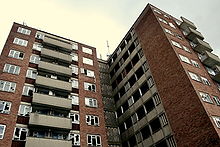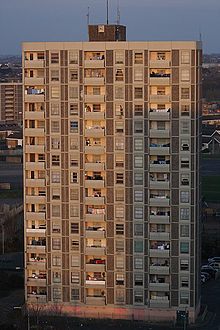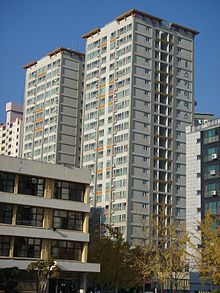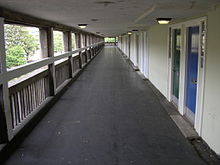- Tower block
-
A tower block, high-rise, apartment tower, office tower, apartment block, or block of flats, is a tall building or structure used as a residential and/or office building. In some areas they may be referred to as "MDU" standing for "Multi Dwelling Unit".[1]
High-rise buildings became possible with the invention of the elevator (lift) and cheaper, more abundant building materials. The materials used for the structural system of high-rise buildings are reinforced concrete and steel. Most North American style skyscrapers have a steel frame, while residential blocks are usually constructed out of concrete. There is no clear definition of any difference between a tower block and a skyscraper though a building lower than about thirty stories is not likely to be a skyscraper and a building with fifty or more stories is certainly a skyscraper. [1]
High-rise structures pose particular design challenges for structural and geotechnical engineers, particularly if situated in a seismically active region or if the underlying soils have geotechnical risk factors such as high compressibility or bay mud. They also pose serious challenges to firefighters during emergencies in high-rise structures. New and old building design, building systems like the building standpipe system, HVAC systems (Heating, Ventilation and Air conditioning), fire sprinkler system and other things like stairwell and elevator evacuations pose significant problems.
Apartment blocks have technical and economic advantages in areas with high population density. They have become a distinguished form of housing accommodation in virtually all densely populated urban areas around the world. In contrast with low-rise and single-family houses, apartment blocks accommodate more inhabitants per unit of area of land they occupy and also decrease the cost of municipal infrastructure.
Contents
History
High-rise apartment buildings had already appeared in antiquity: the insulae in ancient Rome and several other cities in the Roman Empire, some of which might have reached up to 10 or more storeys,[2] one reportedly having 200 stairs.[3] Because of the destruction caused by poorly-built high-rise insulae collapsing,[4] several Roman emperors, beginning with Augustus (r. 30 BC - 14 AD), set limits of 20–25 metres for multi-story buildings, but met with limited success,[5][6] as these limits were often ignored despite the likelihood of taller insulae collapsing.[7] The lower floors were typically occupied by either shops or wealthy families, while the upper storeys were rented out to the lower classes.[8] Surviving Oxyrhynchus Papyri indicate that seven-storey buildings even existed in provincial towns, such as in 3rd century AD Hermopolis in Roman Egypt.[9][9]
In Arab Egypt, the initial capital city was Fustat. It housed many high-rise residential buildings, some seven storeys tall that could reportedly accommodate hundreds of people. Al-Muqaddasi in the 10th century described them as resembling minarets, while Nasir Khusraw in the early 11th century described some of them rising up to 14 storeys, with roof gardens on the top storey complete with ox-drawn water wheels for irrigating them.[10][11] By the 16th century, Cairo also had high-rise apartment buildings where the two lower floors were for commercial and storage purposes and the multiple storeys above them were rented out to tenants.[12]
The skyline of many important medieval cities was dominated by large numbers of high-rising urban towers which fulfilled defensive, but also representative purposes. The residential Towers of Bologna numbered between 80 to 100 at a time, the largest of which still rise to 97.2 m. In Florence, a law of 1251 decreed that all urban buildings should be reduced to a height of less than 26 m, the regulation immediately put into effect.[13] Even medium-sized towns such as San Gimignano are known to have featured 72 towers up to 51 m height.[13]
Tower blocks were built in the Yemeni city of Shibam in the 16th century. The houses of Shibam are all made out of mud bricks, but about 500 of them are tower houses, which rise 5 to 16 storeys high,[14] with each floor having one or two apartments.[15][16] This technique of building was implemented in order to protect residents from Bedouin attacks. While Shibam has existed for around 2,000 years, most of the city's houses come mainly from the 16th century. The city has the tallest mud buildings in the world, with some of them over 30 metres (100 feet) high.[17] Shibam has been called "one of the oldest and best examples of urban planning based on the principle of vertical construction" or "Manhattan of the desert".[16]
Currently, the tallest high-rise apartment building in the world is Chicago's John Hancock Center, constructed under the supervision of Skidmore, Owings & Merrill and completed in 1969. The building has 100 stories and stands at 344 meters tall.[18]
Modern development
United Kingdom
Tower blocks were built in the UK after the Second World War. The first residential tower block, "The Lawn" was constructed in Harlow, Essex in 1951; it is now a Grade II listed building. In many cases Tower Blocks were seen as a "quick-fix" to cure problems caused by crumbling and unsanitary 19th century dwellings or to replace buildings destroyed by German aerial bombing. Initially, they were welcomed, and their excellent views made them popular living places. Later, as the buildings themselves deteriorated, they grew a reputation for being undesirable low cost housing, and many tower blocks saw rising crime levels, increasing their unpopularity. One response to this was the great increase in the number of housing estates built, which in turn brings its own problems. In the UK, tower blocks particularly lost popularity after the partial collapse of Ronan Point in 1968. Glasgow, the largest city in Scotland, is believed to contain the highest concentration of tower blocks in the UK - examples include the Hutchesontown C blocks in the Gorbals, the 20-storey blocks in Sighthill, and the 31-storey Red Road (flats) in the city's north east.[citation needed] However, on the whole, London has the largest number of high-rise residential buildings in the UK.[citation needed]
- The post-war British tower block vision
Post-war Britain was the stage for a tower block building ‘boom’; from the 1950s to the late 1970s there was a dramatic increase in tower block construction. During this time, local authorities desired to impress their voters by building futuristic and imposing tower blocks, which would signify post-war progress.[19] Both Patrick Dunleavy and Lynsey Hanley agree that architects and planners were influenced by Le Corbusier’s promotion of high-rise architecture.[20][21] The modern tower blocks were to include features that would foster desired forms of resident interaction, an example being the inclusion of Le Corbusier’s streets in the sky in some estates.[22]
As well as inspiring residents, local authority planners believed that the way tower blocks were constructed would save money.[23] Generally, the tower blocks were built on cheap greenfield land skirting established cities.[24] Although the property prices for these periphery sites were markedly cheaper than their inner city counterparts, they often had little access to public amenities, such as public transport.[21] It was thought that the implementation of industrialised building techniques would lower costs too, as similar tower blocks would be replicated over many sites.[24] Uniform and standardised parts, such as toilet fittings and door handles, would be fitted throughout many tower blocks – planners deemed that buying in bulk would reduce overall costs.[24]
Another key aspect of the tower block vision was the 'Brutalist' architectural method, popular with architects and planners at the time. The Brutalist emphasis led to the construction of stark and striking tower blocks with large sections of exposed concrete.[25] Concrete was to be an integral part of the tower block designs; it could be poured on site, offering boundless flexibility to the building designers.[26] To the planners, concrete was a silver bullet for the construction process – it was economical, and 'was vaunted as being long-lasting, if not indestructible'.[27]
- The post war British tower block reality
Coleman's 1985 work argues that in trying to emulate Le Corbusier's ideas, the tower block planners only succeeded in encouraging social problems.[28] Although architects and local authorities intended the opposite, tower blocks quickly became, as Hanley sharply stated, 'slums in the sky'.[21] Due to demanding deadlines, complicated construction practices were rushed and many tower blocks experienced structural decay as a result – roofs leaked, concrete suffered spalling, steel corroded, and damp penetrated the buildings.[29] Unfortunately, by replicating tower blocks across the nation, planners 'disastrously' replicated design faults.[24] In many tower blocks, concrete quickly exhibited signs of decay; cracks soon formed and destabilised the buildings.[26] The partial collapse of the Ronan Point tower block is an infamous example of the hasty and substandard construction that occurred in a number of the towers. The tower blocks quickly lost their 'futuristic' look; concrete turned from the crisp white the designers had imagined to a dull grey, stained by pollution.[30]
Poor design decisions ruined the anticipated benefits of the buildings. Open spaces, which were supposed to benefit the residents, were instead unattractive, unused and inadequately supervised.[31] Residents felt it was difficult to maintain the large open spaces around the blocks because they realistically belonged to no one.[32] Social problems increased as the tower blocks quickly degraded through poor maintenance and an insecure communal environment.[33] Apart from frequent break-downs, communal lifts were a source of fear for people travelling alone.[34] It was a rarity to 'enter a clean-smelling, undefaced lift'.[35] The tower blocks, many of which were located on the periphery of the city, made residents feel isolated and cut off from society.[36] Outsiders and newcomers were also affected; they felt the overbearing design of the tower blocks made them fearsome and unsociable.[37]
Power argues that as a direct consequence of their design and construction, security problems were prevalent in many of the tower blocks.[29] Break-ins, vandalism and muggings were common, which were aided by the buildings' concealed areas, the mazes of internal corridors, and dark corners.[38] Police were often required in the tower blocks,[21] but their infrequent presence did little to pacify towers rife with delinquency. In order to contain disruptive behaviour, local authorities began to place 'problem families' in the same blocks; Hanley argues that this policy only led to 'further alienation …nihilism and a creeping sense of lawlessness'.[39] Dunleavy seconds this, suggesting that the mental health of long term tower block residents may have been detrimentally affected.[40]
While local authorities and their architects intended to create tower blocks that encouraged harmonious and vibrant communities, often the results were far from ideal. Post-war tower blocks were compromised from the outset by a combination of faults: local authorities advocated impractical architectural methods; design and construction faults were frequently reproduced; and there appeared to be a lack of understanding about the social consequences of certain design features. Collectively, these oversights transformed many tower blocks into undesirable places to live.
- Fire safety
The lives of residents in London Tower blocks are at risk because London councils have not done proper fire safety checks and the problem is probably widespread in the UK. [41] North Ayrshire Council has decided to remove plastic cladding from its buildings following a fatal fire in a tower block.[42] Poor maintenance of electrical equipment, fire doors and other features has caused widespread fire hazards and residents are asked to pay part of the cost of putting this right although residents did not cause the hazards.[43] Tower blocks may be inherently more prone to fire because people living high up can escape fires less easily and the fire brigade can less easily reach them. In buildings with more than a hundred residents ensuring that every single resident acts responsibly to minimize fire risk is impossible, poorer residents in tower blocks may be tempted to use cheaper flammable fuels rather than electricity also are more likely to be smokers and carelessness with cigarettes is a major cause of home fires, furthermore poor residents of tower blocks are more likely to have old furniture which was not made to modern fire safety standards. Fire safety legislation introduced in London in 2006 requires new high rise buildings to be built to higher safety standards with sprinkler systems, these new buildings are mainly luxury accommodation for richer people. The legislation is not retrospective and does not protect poor people living in existing tower blocks.[44]
- Towards the present day
In recent years, some council or ex-council high-rises in the United Kingdom, including Trellick Tower, Keeling House, Sivill House and The Barbican Estate, have become popular with young professionals due to their excellent views, desirable locations and architectural pedigrees, and now command high prices. There are plans to redevelop the Little London and Lovell Park areas on the fringes of Leeds city centre into luxury flats for 'Young Urban Professionals'. The plans entail demolishing all of the council housing and refurbishing the highrise flats. This demand has led to many councils rethinking plans regarding their demolition.
After a gap of around 30 years, new high-rise flats are once again being built in Belfast, Birmingham (some are for wealthy people, e.g. The Mailbox, others are student accommodation.), Cardiff, Aberdeen, Glasgow, Leeds, Liverpool, London, Manchester and Newcastle; but this time sometimes for wealthy professionals, rather than the `lower classes`. Their developers market these properties by using the American term 'apartment buildings', perhaps in an effort to distance these newer buildings from the older tower blocks from the 1950s and 1960s. These are usually taller than their older counterparts and generally built in and around these provincial city centres. They are often glass and aluminum clad. Tonight with Trevor McDonald highlighted that in Leeds and Manchester (perhaps the cities that had seen most development) only approximately half were occupied and with owner occupation often being as low as 10%. In Southend there are controversial plans to build new tower blocks for social housing, a supporter claims this will be cheaper than paying to house poor people with private landlords while opponents fear the creation of Ghettos.[45]
Tower blocks in Northern Ireland were never built to the frequency as they were in other cities in Britain and Ireland. Most tower blocks and flat complexes are found in Belfast and Derry, although many of these have been demolished in recent years and replaced with traditional public housing units. The Divis flats complex in west Belfast was built in between 1968 and 1972 was demolished in the early 1990s as the residents demanded new houses due to mounting problems with the flats. Divis Tower, built separately in 1966, still stands, however; and, in 2007, work began to convert the former British Army base at the top two floors into new dwellings.
In the north of the City, the iconic 7 towers complex in the New Lodge remains, although so too the problems that residents face, such as poor piping and inadequate sanitation. Farther north, the 4 tower blocks in Rathcoole still dominate the local skyline, while in south Belfast, the tower blocks in Seymour Hill also remain standing.
Ireland
Most of the tower blocks in Northern Ireland are in Belfast. All of Belfast's flat complexes were built by Belfast Corporation as part of Belfast slum clearances and to solve the housing problem. The Ballymun Flats were built between 1966 and 1969 consisting of seven 15-storey towers, nineteen 8 storey blocks and ten 4 storey blocks.[46] These were the "seven towers" referred to in the U2 song "Running to Stand Still". Inner Dublin flat complexs include Sheriff Street (demolished), Fatima Mansions (demolished and redeveloped), St. Joseph's Gardens (demolished; replaced by Killarney Court flat complex), St. Teresa's Gardens, Dolphin House, Liberty House, St. Michael's Estate and O'Devaney Gardens and a lot more mainly throughout the North and South Inner City of Dublin. Suburban flat complexes were built exclusively on the northside of the city in Ballymun, Coolock and Kilbarrack. These flats were badly affected by a heroin epidemic that hit working-class areas of Dublin in the 1980s and early 90s.
Over the last five years the largest cities such as Dublin, Cork, Limerick and Galway have witnessed new large apartment building. Some large towns such as Navan, Drogheda, Dundalk and Mullingar have also witnessed lots of modern apartments being built.
Eastern Europe
Russia is currently undergoing a dramatic buildout, growing a commercially-shaped skyline. Russians, both poor and wealthy, from Soviet time had conserved the impression of prestige about tower blocks.
East Asia
The unpopularity of tower blocks in Europe is in marked contrast to many Asian countries.
In South Korea the tower blocks are called "Apartment Complex (Apartment Danji)". The first residential towers began to be built after the Korean War. The South Korean government needed to build many apartment complexes in the cities to be able to accommodate the citizens. In the 60 years since, as the population increased considerably, tower blocks have become more common. This time however the new tower blocks integrated shopping malls, parking system and other convenient facilities.
In Singapore and urban Hong Kong, land prices are so high that almost the entire population lives in high-rise apartments. In fact, over 60% of Hong Kong residents live in apartments, many of them condominiums. Tower Palace in Seoul, South Korea, is the tallest apartment complex in Asia.
Canada
In Canada large multi-family buildings are usually known as apartment buildings or apartment blocks if they are rented from one common landowner, or condominiums or condo towers if each dwelling unit is individually owned; they may be called low-rise (or walk-up), mid-rise, high-rise, or skyscraper depending on their height. Tall residential towers are a staple building type in all large cities. Their relative prominence in Canadian cities varies substantially, however. In general, more populated cities have more high-rises than smaller cities, due to a relative the scarcity of land and a greater demand for housing. However, some cities such as Quebec City, Ottawa, and Halifax have fewer high-rise buildings due to several factors: a focus on historic preservation, height restrictions, and lower growth rates. In middle-sized cities with a relatively low population density, such as Calgary, Edmonton, Winnipeg, or Hamilton, there are more apartment towers but they are greatly outnumbered by single-family houses. Most of the largest residential towers in Canada are found in Toronto, Vancouver, and (to a lesser extent) Montreal: the most densely-populated cities. Toronto contains the second largest concentration of high-rise apartment buildings in North America (after New York). In Canada, like in other New World countries, but unlike Western Europe, most high-rise towers are located in the city centre (or "downtown"), where smaller, older buildings were demolished to make way in redevelopment schemes. Toronto, however has many high-rise apartment and condominium communities in its denser suburbs in addition to downtown. Greenfield high-rise development in the suburbs of Canadian cities in much more rare, although it does happen, particularly in transit-oriented developments.
United States
In the United States tower blocks are commonly referred to as "midrise" or "highrise apartment buildings", depending on their height, while buildings that house fewer flats (apartments), or are not as tall as the tower blocks, are called "lowrise apartment buildings".
Some of the first residential towers were the Castle Village towers in New York City completed in 1939. Their cross-shaped design was copied in towers in Parkchester and Stuyvesant Town residential developments.
The government's experiments in the 1960s and 70s to use high-rise apartments as a means of providing the housing solution for the poor resulted in a spectacular failure. All but a few high-rise housing projects in the nation's largest cities, such as Cabrini–Green and Robert Taylor Homes in Chicago, Penn South in New York and the Desire projects in New Orleans, fell victim to the "ghettofication" and are now being torn down, renovated, or replaced.
In contrast to their public housing cousins, commercially developed high-rise apartment buildings continue to flourish in cities around the country largely due to high land prices and the housing boom of the 2000s. The Upper East Side in New York City and Chicago's Gold Coast, both featuring high-rise apartments, are the wealthiest urban neighborhoods in the United States.
Currently, the tallest high-rise apartment building and tower block in the world is Chicago's John Hancock Center, constructed by Bangladeshi engineer Fazlur Khan in 1969. The building has 100 stories and stands at 344 meters tall.[18]
Australia
High-rise living in Australia was limited to small pockets of bohemian inner Sydney until the 1960s, where a short-lived fashion saw public housing tenants located in new high-rise developments, especially in Sydney and Melbourne. The buildings pictured along with four other 16 storey blocks were constructed on behalf of the Royal Australian Navy and were available to sailors and their families for accommodation. Due to social problems within these blocks the Navy left and the Department of Housing took charge and flats were let to low income and immigrant families. During the 1980's many people escaping communisum in Eastern block countries were housed in these buildings. Developers have enthusiastically adopted the term 'apartment' for these new high-rise blocks, perhaps to avoid the stigma still attached to housing commission flats.
Definition
Although there is no precise definition that is universally accepted, various bodies have tried to define what 'high-rise' means:
- Emporis Standards defines a high-rise as "A multi-story structure between 35-100 meters tall, or a building of unknown height from 12-39 floors."[47]
- According to the building code of Hyderabad, India, a high-rise building is one with four floors or more, or one 15 meters or more in height.[48]
- The New Shorter Oxford English Dictionary defines a high-rise as "a building having many stories".
- The International Conference on Fire Safety in High-Rise Buildings defined a high-rise as "any structure where the height can have a serious impact on evacuation"[citation needed]
- Massachusetts, United States General Laws define a high-rise as being higher than 70 feet (21 m).[citation needed]
- Most building engineers, inspectors, architects and similar professions define a high-rise as a building that is at least 75 feet (23 m) tall.[citation needed]
Streets in the sky
Streets in the sky is a term used to describe a style of architecture that emerged in Britain in the 1960s and 1970s. Generally built to replace run-down terraced housing, the new designs included not only modern improvements such as inside toilets, but also shops and other community facilities within high-rise blocks.[49] Examples of the buildings and developments are Trellick Tower, Balfron Tower, Robin Hood Gardens and Keeling House in London, Hunslet Grange in Leeds and Park Hill, Sheffield. These were an attempt to develop a new architecture, differentiated from earlier large housing estates, such as Quarry Hill flats in Leeds.[50][51]
Alison and Peter Smithson were the architects of Robin Hood Gardens.[52] Another large example, the Aylesbury Estate in South London, built in 1970, is about to be demolished.[53][54]
Deck access
Deck access is a term used to describe flats that are accessed from a walkway that is open to the elements, as opposed to flats that are accessed from fully enclosed internal corridors. Deck access blocks of flats are usually fairly low-rise structures. The decks can vary from simple walkways, which may be covered or uncovered, to decks wide enough for small vehicles. The best known example of deck-access flats in the UK is Park Hill, Sheffield, where the decks are wide enough to allow electric vehicles; however, the design is inspired by French Modernist architect Le Corbusier, particularly his Unite D'Habitation in Marseilles.[55]
Green tower blocks
Green tower blocks have some scheme of living plants or Green roofs [2] or solar panels [3] on their roofs and/or incorporate other environmentally friendly design features. [4]
See also
- Apartment Ratings
- Earthquake engineering
- Low-rise
- Prefabrication
- Panelák - the equivalent in Czech Republic
- Plattenbau - the equivalent in East Germany
- Cutie de chibrituri - meaning Matchboxes in Romanian is the equivalent in Romania
- Skyscraper
- Wind engineering
- Out My Window, a web documentary about life in high-rise apartments around the world
References
- ^ BICSI McGraw-Hill Professional, 2002, ISBN 0071382119
- ^ Gregory S. Aldrete: "Daily Life in the Roman City: Rome, Pompeii and Ostia", 2004, ISBN 9780313331749, p.79f.
- ^ Martial, Epigrams, 27
- ^ Gregory S. Aldrete (2004), Daily Life in the Roman City: Rome, Pompeii and Ostia, p. 78, ISBN 9780313331749
- ^ Strabo, 5.3.7
- ^ Alexander G. McKay: Römische Häuser, Villen und Paläste, Feldmeilen 1984, ISBN 3761105851 p. 231
- ^ Gregory S. Aldrete (2004), Daily Life in the Roman City: Rome, Pompeii and Ostia, pp. 78-9, ISBN 9780313331749
- ^ Gregory S. Aldrete: "Daily Life in the Roman City: Rome, Pompeii and Ostia", 2004, ISBN 9780313331749, p. 79 ff.
- ^ a b Papyrus Oxyrhynchus 2719, in: Katja Lembke, Cäcilia Fluck, Günter Vittmann: Ägyptens späte Blüte. Die Römer am Nil, Mainz 2004, ISBN 3-8053-3276-9, p. 29
- ^ Behrens-Abouseif, Doris (1992), Islamic Architecture in Cairo, Brill Publishers, p. 6, ISBN 90 04 09626 4
- ^ Joan D. Barghusen, Bob Moulder (2001), Daily Life in Ancient and Modern Cairo, Twenty-First Century Books, p. 11, ISBN 0822532212
- ^ Mortada, Hisham (2003), Traditional Islamic principles of built environment, Routledge, p. viii, ISBN 0700717005
- ^ a b Werner Müller: "dtv-Atlas Baukunst I. Allgemeiner Teil: Baugeschichte von Mesopotamien bis Byzanz", 14th ed., 2005, ISBN 978-3423030205, p.345
- ^ Helfritz, Hans (April 1937), "Land without shade", Journal of the Royal Central Asian Society 24 (2): 201–16, doi:10.1080/03068373708730789
- ^ Pamela Jerome, Giacomo Chiari, Caterina Borelli; Chiari, Giacomo; Borelli, Caterina (1999), "The Architecture of Mud: Construction and Repair Technology in the Hadhramaut Region of Yemen", APT Bulletin 30 (2–3): 39–48 [44], doi:10.2307/1504639, JSTOR 1504639
- ^ a b Old Walled City of Shibam, UNESCO World Heritage Centre
- ^ Shipman, J. G. T. (June 1984), "The Hadhramaut", Asian Affairs 15 (2): 154–62, doi:10.1080/03068378408730145
- ^ a b John Hancock Center, Emporis
- ^ Hanley, L. (2007) Estates: an intimate history, London, Granta Books, p. 104.
- ^ Dunleavy, P. (1981) The politics of mass housing in Britain, 1945-1975, Oxford, U.K, Clarendon Press
- ^ a b c d Hanley, L. (2007) Estates: an intimate history, London, Granta Books.
- ^ Dunleavy, P. (1981) The politics of mass housing in Britain, 1945-1975, Oxford, U.K, Clarendon Press, p. 57.
- ^ Dunleavy, P. (1981) The politics of mass housing in Britain, 1945-1975, Oxford, U.K, Clarendon Press, p. 84.
- ^ a b c d Power, A. (1997) Estates on the edge, Great Britain, MacMillan, p. 57.
- ^ Dunleavy, P. (1981) The politics of mass housing in Britain, 1945-1975, Oxford, U.K, Clarendon Press, p. 58
- ^ a b Power, A. (1997) Estates on the edge, Great Britain, MacMillan, p. 59.
- ^ Power, A. (1997) Estates on the edge, Great Britain, MacMillan, p. 58.
- ^ Lund, B. (1996) Housing problems and housing policy, New York, Longman, p. 127.
- ^ a b Power, A. (1997) Estates on the edge, Great Britain, MacMillan, p. 93.
- ^ Hanley, L. (2007) Estates: an intimate history, London, Granta Books, p. 119
- ^ Dunleavy, P. (1981) The politics of mass housing in Britain, 1945-1975, Oxford, U.K, Clarendon Press, p. 98.
- ^ Power, A. (1997) Estates on the edge, Great Britain, MacMillan, p. 92.
- ^ Power, A. (1997) Estates on the edge, Great Britain, MacMillan, p. 111.
- ^ Power, A. (1987) Property before people, London, Allen & Unwin, p. 143.
- ^ Power, A. (1987) Property before people, London, Allen & Unwin, p. 144.
- ^ Power, A. (1997) Estates on the edge, Great Britain, MacMillan, p. 95.
- ^ Power, A. (1997) Estates on the edge, Great Britain, MacMillan.
- ^ Dunleavy, P. (1981) The politics of mass housing in Britain, 1945-1975, Oxford, U.K, Clarendon Press, p. 97.
- ^ Hanley, L. (2007) Estates: an intimate history, London, Granta Books, p. 124
- ^ Dunleavy, P. (1981) The politics of mass housing in Britain, 1945-1975, Oxford, U.K, Clarendon Press, p. 99
- ^ http://news.bbc.co.uk/1/hi/england/london/8278657.stm
- ^ http://news.bbc.co.uk/1/hi/uk_politics/370792.stm
- ^ http://www.guardian.co.uk/society/2010/jan/03/huge-fire-safety-bills-towerblock-residents
- ^ http://news.bbc.co.uk/1/hi/england/london/8139264.stm
- ^ http://www.echo-news.co.uk/news/8763599.Anna_Waite__We_need_more_apartment_blocks_in_Southend/
- ^ "RTÉ News: Demolition of famous Dublin tower block". www.rte.ie. http://www.rte.ie/news/2005/0313/ballymun.html. Retrieved 2010-05-19.
- ^ Data Standards: high-rise building (ESN 18727), Emporis Standards. Accessed on line October 16, 2009.
- ^ p. 57, Urban redevelopment: a study of high-rise buildings, K. Narayan Reddy, Concept Publishing Company, 1996, ISBN 8170225310.
- ^ "Streets in the Sky". Intute.ac.uk. 2006-11-01. http://www.intute.ac.uk/hottopics/2006/11/streets-in-the-sky/. Retrieved 2010-08-08.
- ^ Quarry Hill at BBC Online
- ^ "Social Engineering Through Architectural Change". Newenglishreview.org. http://www.newenglishreview.org/custpage.cfm/frm/42007/sec_id/42007. Retrieved 2010-08-08.
- ^ "Alison and Peter Smithson, Design Museum". Designmuseum.org. http://designmuseum.org/design/alison-peter-smithson. Retrieved 2010-08-08.
- ^ Demolition of the Aylesbury Estate: a new dawn for Hell's waiting room?, The Times, 20 October 2008
- ^ "Aylesbury Tenants First". Aylesbury Tenants First. http://aylesburytenantsfirst.org.uk/. Retrieved 2010-08-08.
- ^ BBC 'English Heritage' documentary about Park Hill flats.
External links
- Sustaining Tower Blocks
- World's tallest residential towers
- East European blocks of flats today
- Photos of Apartment Blocks from around the world
- News on the Block - a magazine all about flats
Real estate developments Commercial Business park · Office building · Ports and waterfronts · Retail park · Shopping mall / center · Shopping streets and districts · Warehouse DistrictIndustrial Residential Science / Education Municipal Buildings Miscellaneous Categories:- Apartment types
Wikimedia Foundation. 2010.


